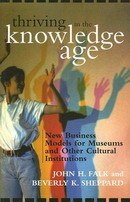
The two authors of Thriving in the Knowledge Age, John H Falk and Beverly K Sheppard, aim to bring together two strands of knowledge: 'a deep understanding of museums' and 'a comprehensive awareness of business practices and ideas' (p. ix). The book has been revised after comments from well-known stakeholders in the museums field such as Des Griffin, the late Stephen Weil, and Lynn Dierking. It also acknowledges its indebtedness to the ideas of key writers in the non-profit sphere, such as the late Peter Drucker. Their ideas are evident on a first reading of this easy-to-read book. Much of the message mirrors the work of Drucker's engrossing Post-Capitalist Society or even The Age of Uncertainty by Charles Handy, a British author not acknowledged as a source of ideas in the foreword but nonetheless an influential business writer. In line with those authors, Falk and Sheppard have produced a book that is engaging and presents ideas that are sound academically but at the same time readable.
While these ideas are not new to the broader non-profit sector, they are new to the museum sector. As such, this book is worthwhile and innovative in approach. It also shows how far museums have come since they began to be democratised, restructured and opened to a wider audience base in the 1970s.
The book is written from a United States perspective and the authors readily acknowledge their bias in writing about what they know best — American museums. This approach does not distract from their key message. The book is divided into ten chapters and four parts. The first part explains doing business in the knowledge age; the second scans the environments of yesterday, today and tomorrow; the third builds a knowledge age business model; the fourth implements and sustains this model. The book concludes with seven pages of references, enough to keep the hungry student of museum management busy for some time. Each chapter concludes with discussion questions and notes. All in all, it is a comprehensive and useful book for the museum curator, director, trustee, volunteer, or student of museum studies or arts management.
The central notion in the book revolves around the need for a new business model for museums. The authors argue that the industrial age business model was linear, top-down, static, and organisation-centred, isolated from the world around it. They contrast this model with the knowledge age business model which is bottom-up, changing, flexible, audience-centred and open to the discontinuous change occurring in society. Falk and Sheppard argue that 'rather than a linear model, this new model takes a systems approach — all pieces interact and feed back upon each other' (p. 22). Each model is presented diagramatically and the following chapters of the book are arranged around the models.
What interests me most about this book is that it was written at all. There are very few books or articles in the museum sector that integrate the business and museum management needs. On the one hand, there are managers and marketers writing on museum management and marketing for management and marketing journals — journals that museum people would never read. On the other hand, there are museum people writing on a variety of matters for museum journals that most management or marketing academics do not read. Usually, ne'er the twain shall meet. Here, there is a meeting of minds of museum experts and business knowledge, to provide a new sort of book whose time has come in the museum literature.
Readers might well flinch at the preface, in which Falk and Sheppard discuss themselves in the third person: 'John became increasingly concerned about the long-term sustainability of museums and the business models on which they were based ... Beverly ... shared a similar concern' (p. viii). But readers who manage to get past this patronising hurdle will find a work that successfully brings together different approaches to the business of museums. It is well worth a read and should be on all relevant university course reading lists.
Ruth Rentschler is associate professor of arts and entertainment management and executive director of the Centre for Leisure Management Research at Deakin University, Melbourne.
